 |
|
The Sumitomo Group Public Affairs Committee strives to support college students’ negotiation skills, assist in upgrading higher education and contribute to global human resource development through the Intercollegiate Negotiation Competition.
The 10th intercollegiate negotiation competition was held at Sophia University in Tokyo, December 3rd and 4th, 2011. This year’s competition featured students from 19 schools: Sophia University, Osaka University, Gakushuin University, Doshisha University, University of Tokyo, Waseda University, Chuo University, Kyushu University, Kyoto University, Nagoya University, Tohoku University, Hitotsubashi University, Keio University, Ritsumeikan University, Hokkaido University, a tag team of the Australian National University and The University of Sydney which also attended last year as well as Nihon University and Shanghai Jiao Tong University which joined for the first time this year. In total, 263 undergraduate and graduate students from these 19 universities performed enthusiastically.
|
 |
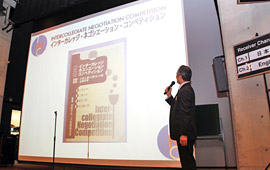
Opening ceremony
|
| |
|
|
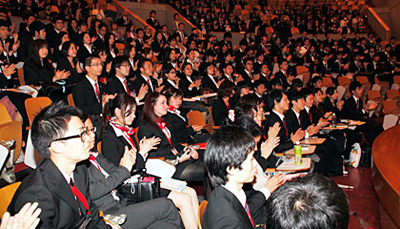 |
|
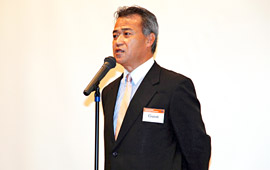
Masatoshi Hayashi, Secretary General, Sumitomo Group Public Affairs Committee
|
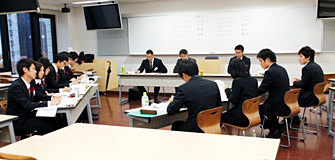
Performance in Japanese
|
 |
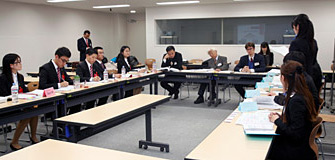
Performance in English
|
Pairing
<Japanese>
|
|
Round A/arbitration
|
Round B/negotiation
|
|
Red
|
Blue
|
Red
|
Blue
|
|
1
|
Hitotsubashi2
|
Kyushu1
|
Sophia3
|
Kyoto1
|
|
2
|
Nihon1
|
Osaka1
|
Hokkaido2
|
Doshisha2
|
|
3
|
Keio1
|
Doshisha2
|
Tohoku1
|
Chuo2
|
|
4
|
Shanghai
|
Kyoto2
|
Shanghai
|
Waseda1
|
|
5
|
Hokkaido1
|
Gakushuin1
|
Hitotsubashi2
|
Osaka1
|
|
6
|
Australia
|
Gakushuin2
|
Tohoku2
|
Waseda3
|
|
7
|
Sophia1
|
Tokyo2
|
Sophia2
|
Doshisha1
|
|
8
|
Ritsumeikan2
|
Chuo1
|
Australia
|
Tokyo2
|
|
9
|
Sophia3
|
Kyushu2
|
Hitotsubashi1
|
Chuo1
|
|
10
|
Ritsumeikan1
|
Waseda3
|
Hokkaido1
|
Kyoto2
|
|
11
|
Sophia2
|
Waseda2
|
Ritsumeikan2
|
Osaka2
|
|
12
|
Nihon2
|
Kyoto1
|
Sophia1
|
Gakushuin1
|
|
13
|
Hokkaido2
|
Tokyo1
|
Keio2
|
Tokyo1
|
|
14
|
Tohoku1
|
Osaka2
|
Nihon2
|
Gakushuin2
|
|
15
|
Hitotsubashi1
|
Waseda1
|
Keio1
|
Waseda2
|
|
16
|
Keio2
|
Chuo2
|
Ritsumeikan1
|
Kyushu2
|
|
17
|
Tohoku2
|
Doshisha1
|
Nihon1
|
Kyushu1
|
<English>
|
|
Round A/arbitration
|
Round B/negotiation
|
|
Red
|
Blue
|
Red
|
Blue
|
|
1
|
Keio
|
Kyushu1
|
Sophia2
|
Kyushu1
|
|
2
|
Sophia1
|
Kyoto2
|
Shanghai
|
Tokyo
|
|
3
|
Australia
|
Kyushu2
|
Sophia1
|
Nagoya
|
|
4
|
Sophia2
|
Osaka
|
Australia
|
Osaka
|
|
5
|
Ritsumeikan1
|
Nagoya
|
Tohoku
|
Kyushu2
|
|
6
|
Tohoku
|
Tokyo
|
Ritsumeikan1
|
Kyoto2
|
|
7
|
Hitotsubashi
|
Kyoto1
|
Ritsumeikan2
|
Doshisha
|
|
8
|
Shanghai
|
Doshisha
|
Hitotsubashi
|
Gakushuin
|
|
9
|
Ritsumeikan2
|
Gakushuin
|
Keio
|
Kyoto1
|
|
Problem establishment and competition outline (Red vs. Blue companies)
|
The competition has two major parts, “arbitration” (Round 1), and “negotiation” (Round 2), with each part having a Japanese version and English version. Each team was divided into two sides, the Red company, which played the role of a synthetic fiber company in the fictional country of Negoland and the Blue company, which played the role of a Telecommunications systems company in Arbitria, a neighboring country of Negoland.
Red company had a contract with Blue company for the development of a system in building a Chemical fiber factory in Arbitria and also made a national agreement of free trade with Negoland. Although there were some problems and the system development process got delayed, forcing the Red company to pay a penalty for loss of revenue to their customers. The Red company demanded Blue Company to pay the damage for their operational delays. In response, the Blue Company demanded Red company pay an increased invoice for the development of the system, giving the reason for the delay was caused by more processes than was originally planned. In addition there was another collaborative project between the companies in the development of a lithium ion battery for electric cars which also resulted in a penalty for damage in that deal as well.
In Round1 of arbitration on the first day, the point of discussion was about “which company is responsible for paying for the penalty and damages?” In the Round 2 of negotiation, on the second day, the negotiations were tense because of the difficulties encountered with different situations, such as another collaborative project between Red Company and Blue Company in which they were hired to work on a water treatment plant by a committee of water treatment representatives which required various negotiations between them as they completed the job.
|
 |
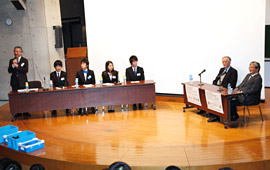
Discussion at Sophia University
|
Judges
|
Every year, the Sumitomo Public Affairs Committee receives assistance with the competition from many people and groups. This year, we were appreciative of the cooperation of people in judicial circles, professionals from each participating university as well as the Judicial Affairs Divisions of various corporations. As the competitions take place each year and students graduate, both male and female alumni return to the competition and now serve as judges for the competition. They also serve in various other support capacities and these groups continue to grow in number. Also in the panel discussion, we had two special guests, Yasuhei Taniguchi, an Honors professor of Kyoto University, who is a director of Japan Association of Arbitrators and Mitoji Yabunaka, a special invitational professor of Ritsumeikan University, who was the last vice minister for foreign affairs.
|
Results of the 10th Intercollegiate Negotiation Competition.
Each school compete with all their abilities, so it was a difficult to judge because they were quite equal just as in past competitions, but the Waseda University won the prize for first time and got the newly redesigned Sumitomo Trophy.
The final results for 2010 are as follows
The 1st prize : Waseda University
The 2nd prize : Sophia University
The 3rd prize : Osaka University
The 4th prize : Keio University
The 5th prize : University of Tokyo
|
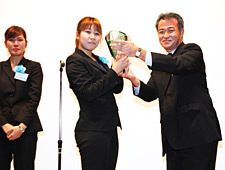
Presentation of championship cup
|
 |
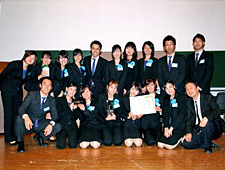
The Wasrda University, winner of the 10th Intercollegiate Negotiation Competition.
|
 |
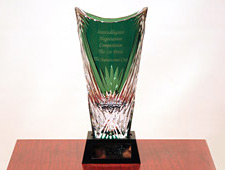
The newly redesigned Sumitomo Trophy.
|
|